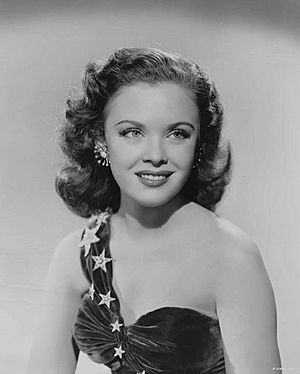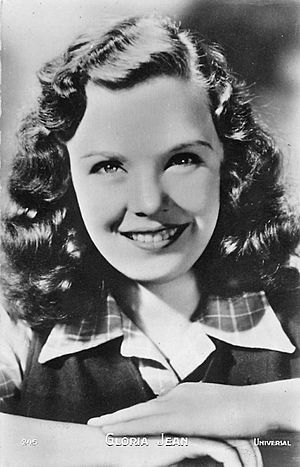Gloria Jean facts for kids
Quick facts for kids
Gloria Jean
|
|
|---|---|

Jean in 1947
|
|
| Born |
Gloria Jean Schoonover
April 14, 1926 Buffalo, New York, U.S.
|
| Died | August 31, 2018 (aged 92) Mountain View, Hawaii, U.S.
|
| Resting place | Mountain View Community Cemetery, Hawaii, U.S. |
| Occupation |
|
| Years active | 1929–1962 |
| Spouse(s) |
Franco Cellini
(m. 1962; div. 1966) |
| Children | 1 |
Gloria Jean (born Gloria Jean Schoonover; April 14, 1926 – August 31, 2018) was a talented American actress and singer. She became famous as a child star, appearing in many movies from 1939 to 1959. Gloria Jean also performed on radio, television, stage, and in nightclubs. Many people remember her best for her role with the famous comedian W. C. Fields in the movie Never Give a Sucker an Even Break (1941).
Contents
Early Life and Beginnings
Gloria Jean Schoonover was born in Buffalo, New York. Her family had roots in Pennsylvania. She had three sisters: Sally, Lois, and Bonnie. Her family was very involved in her career. Her sister Lois often worked as her stand-in, and her father helped manage her career. Gloria Jean started singing on the radio when she was only three years old. Back then, she was known by the cute name "Baby Skylark."
A Young Singer's Journey
Later, Gloria Jean's family moved to Scranton, Pennsylvania. There, she sang with Paul Whiteman's orchestra on radio shows. When she was 12, she joined a small opera company in New York. This made her the youngest person ever to be part of an opera group in the United States. She was training to be a coloratura soprano, which means she had a very high and flexible singing voice.
Becoming a Movie Star
Joining Universal Studios
In 1938, Gloria Jean's voice teacher, Leah Russel, took her to an audition. It was for Universal Pictures, a big movie company. The producer, Joe Pasternak, was looking for a new young singer. He had helped Deanna Durbin become a star. Now that Deanna was taking on older roles, Joe wanted a younger singer for similar musical movies.
The audition was for a film called The Under-Pup. Gloria Jean remembered that there were "hundreds of beautiful little girls" there. She felt a bit messy, with pigtails and slightly crooked teeth. But Joe Pasternak liked her natural look. During her audition, she told him the piano was out of tune, which surprised her mother! Joe liked her honesty and asked her to come back the next day. She sang well, and out of many hopefuls, Gloria Jean won the part.
First Big Roles
After signing with Universal, Gloria Jean got the main role in The Under-Pup (1939). She starred alongside Robert Cummings and Nan Grey. The movie was a success, and Gloria Jean quickly became popular with movie fans. At first, Universal's publicity team said she was 11, not 13, to make her seem even younger.
She then co-starred with Bing Crosby in If I Had My Way (1940). This movie was written, produced, and directed by David Butler. Next, she starred in A Little Bit of Heaven (1940). This film brought her back with many actors from The Under-Pup, including Nan Grey. Robert Stack played the male lead.
Her fourth movie became her most famous: Never Give a Sucker an Even Break (1941). In this film, she co-starred with the legendary comedian W. C. Fields. Gloria Jean later said that even though he had a reputation for not liking children, he was very kind to her.
Wartime Musicals
During World War II, Universal Studios made many musical movies. Gloria Jean became one of their busiest stars, making 14 films during the war years. Most of these were "hepcat" musicals, which were popular with teenagers. Universal often used these movies to introduce new young actors like Donald O'Connor, Peggy Ryan, and Mel Tormé.
She appeared with The Andrews Sisters in What's Cookin' (1942). Then she starred with Donald O'Connor and Peggy Ryan in Get Hep to Love (1942) and When Johnny Comes Marching Home (1942). She and Donald O'Connor were the top stars in It Comes Up Love (1943) and Mister Big (1943).
Trying New Roles
In 1943, Gloria Jean took on her first serious acting role. She played a blind girl in a part of the movie Flesh and Fantasy. Her performance was highly praised. However, the studio decided to remove her part from the final movie. This was a "heartbreak" for Gloria, as it was her first chance to do real drama.
Universal tried to help Gloria Jean move from child roles to adult roles. She was growing up but not yet ready for grown-up leading parts. In 1944, Universal announced plans to make her an adult star. She continued making musicals, co-starring with Olsen and Johnson in Ghost Catchers (1944). She also starred in Pardon My Rhythm (1944), Reckless Age (1944), and I'll Remember April (1945). In May 1944, she turned eighteen.
When her contract with Universal ended in 1944, her agent advised her not to renew it. He thought she needed time to switch from child to adult roles. Universal had already promised movie theaters three more Gloria Jean films for 1945. So, they quickly finished three movies that were already partly done. Her part from Flesh and Fantasy was made into a full movie called Destiny (1944). She also starred in River Gang (1945) and Easy to Look At (1945).
After Universal
After leaving Universal, Gloria Jean went on tours across America and Europe. However, her European tour ended early due to a misunderstanding about a song she sang. When she returned to Hollywood, she faced challenges. Her family lawyer had taken her money, and she owed a lot in taxes. Also, directors were not eager to hire former child stars. She later said it was a mistake to stay away from Hollywood for so long.
She continued her movie career as a freelance actress, working for different studios like United Artists, Columbia Pictures, and Allied Artists. One of her most famous films from this time was Copacabana (1947) with Groucho Marx. She also made four films directed by Arthur Dreifuss: I Surrender Dear (1948), Manhattan Angel (1949), An Old-Fashioned Girl (1949), and There's a Girl in My Heart (1949).
Television and Later Films
In the early 1950s, Gloria Jean started appearing on TV shows. These included Hollywood Theatre Time, Death Valley Days, and The Colgate Comedy Hour. She also made six short musicals for television called Snader Telescriptions.
She continued to act in movies, though they were often smaller productions. Wonder Valley (1953) was her first color movie, but sadly, no copies of it are known to exist today. Her next film was Air Strike (1955), a military drama.
After Air Strike, Gloria Jean took a job as a hostess at a restaurant in California. She enjoyed it, and sometimes even managed the place. Other famous people were surprised to see a movie star working in a restaurant. This led to news stories about her.
A Hollywood producer named Edward Finney read one of these stories. He was a fan of Gloria Jean and hired her to star in the comedy Laffing Time (filmed in 1959). Jerry Lewis also heard about her working in a restaurant. He gave her a singing role in his movie The Ladies Man (1961). However, most of her scenes were cut from the final film. This was her last movie appearance.
Her final acting roles were on TV shows like The Dick Powell Theatre, Lockup, and Saints and Sinners.
Personal Life
In 1962, Gloria Jean married Franco Cellini, who was also an actor. They later divorced in 1966. They had one son named Angelo.
In 1965, she decided to get a regular job. She worked as a receptionist for Redken Cosmetics until 1993. She said in 1986 that she was very happy. She felt she had a wonderful past and a happy present.
Renewed Interest in Her Work
In December 1991, Gloria Jean received a special award from the Young Artist Foundation. It was the "Lifetime Achievement" Award for former child stars. This recognized her great work in the film industry as a young performer. Gloria Jean also attended events where she met fans and signed autographs. She always kept in touch with her fans and friends throughout her life.
More recently, Gloria Jean's films have been getting new attention. If I Had My Way and Never Give a Sucker an Even Break have been released on DVD. Documentaries about W. C. Fields often include clips of Gloria Jean talking about working with him. Universal Pictures has also made new copies of her films Mister Big and Get Hep to Love for theaters. Her 1947 film Copacabana is also available for people to watch at home.
Later Years
After retiring from Redken, Gloria Jean lived in California with her sister, Bonnie. After Bonnie passed away in 2007, Gloria moved to Hawaii to live with her son Angelo and his family. Angelo passed away in 2017. In her very later years, she had some health problems. Gloria Jean passed away from heart failure and pneumonia on August 31, 2018, in a hospital in Mountain View, Hawaii. She is remembered by her daughter-in-law and four grandchildren.
Her official biography, Gloria Jean: A Little Bit of Heaven, was published in 2005. A website dedicated to her, GloriaJeanSings.com, was also created with her help. You can find videos of her from recent years online.
Filmography
| Year | Film | Role | Notes |
|---|---|---|---|
| 1939 | The Under-Pup | Pip-Emma Binns | First Universal picture |
| 1940 | If I Had My Way | Patricia Johnson | |
| A Little Bit of Heaven | Midge Loring | ||
| 1941 | Never Give a Sucker an Even Break | W. C. Fields's niece, Gloria Jean | |
| Jingle Belles | Song specialties | Short (reissued as Winter Serenade) | |
| 1942 | What's Cookin'? | Sue Courtney | |
| Get Hep to Love | Doris Stanley | (released outside the United States as She's My Lovely) | |
| When Johnny Comes Marching Home | Marilyn Benton | ||
| 1943 | It Comes Up Love | Victoria Peabody | (released outside the United States as A Date with an Angel) |
| Mister Big | Patricia Davis | ||
| Moonlight in Vermont | Gwen Harding | ||
| 1944 | Ghost Catchers | Melinda Marshall | |
| Pardon My Rhythm | Jinx Page | ||
| Reckless Age | Linda Wadsworth | ||
| Destiny | Jane Broderick | Includes sequence deleted from Flesh and Fantasy | |
| 1945 | I'll Remember April | April Garfield | |
| Easy to Look At | Judy Dawson | Last Universal picture | |
| River Gang | Wendy | Filmed earlier by Universal; released outside the United States as Fairy Tale Murder | |
| 1947 | Copacabana | Anne Stuart | United Artists |
| 1948 | I Surrender Dear | Patty Nelson, aka Patty Hart | Columbia |
| Manhattan Angel | Gloria Cole | Columbia | |
| An Old Fashioned Girl | Polly Milton | Eagle-Lion | |
| 1949 | There's a Girl in My Heart | Ruth Kroner | Allied Artists |
| 1953 | Wonder Valley | Independent; no known usable prints exist | |
| 1955 | Air Strike | Marge Huggins | Lippert |
| 1959 | Laffing Time (reissued as The Madcaps) | Sally Suffer | Independent |
| 1961 | The Ladies' Man | Girl in boarding house | Paramount |


